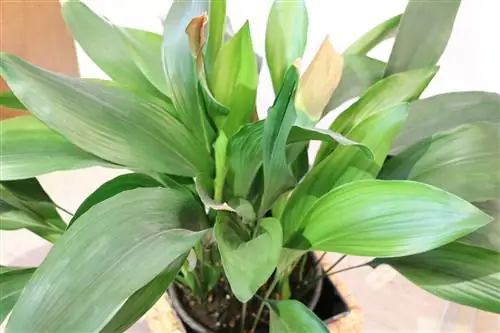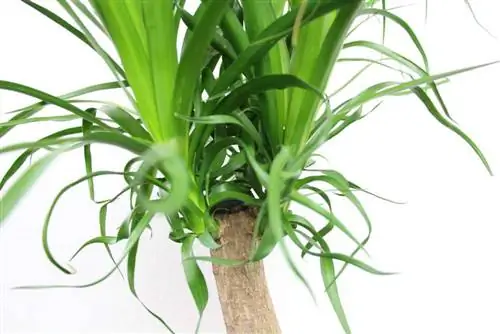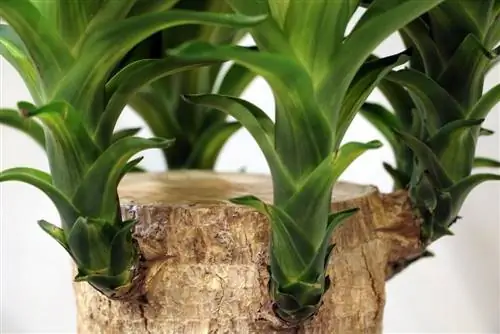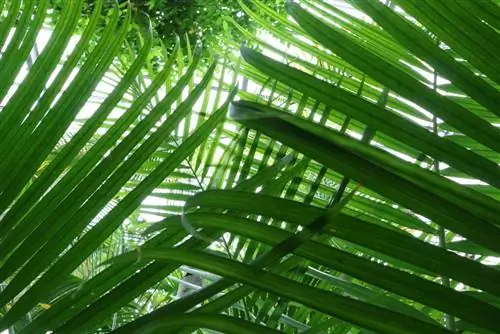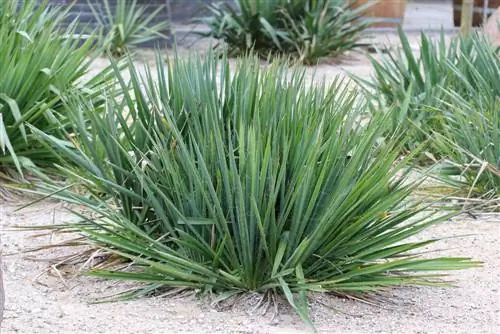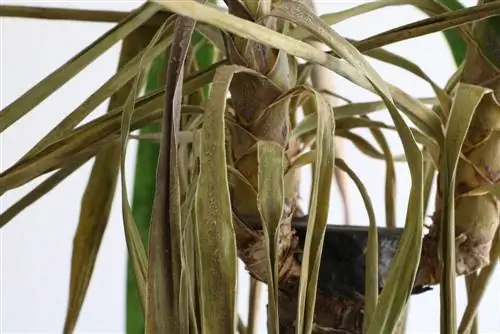- Author admin [email protected].
- Public 2023-12-17 03:39.
- Last modified 2025-01-24 12:45.
The cobbler's palm, also known as the butcher's palm, is one of the houseplants that found its way into our homes a long time ago. The evergreen plant owes its popularity and widespread distribution primarily to its easy care. More than 150 years ago it stood in dimly lit cobblers' workshops or on butchers' counters. This is where its unusual name comes from. It has a reputation for being able to survive even in the darkest corners and with virtually no care. But even the robust cobbler palm cannot survive without light, nutrients and water.
Short profile
- Botanical name: Aspidistra elatior
- other names: butcher palm, shield flower, shield scar, iron plant
- belongs to the asparagus family
- Growth height: 50 to 70 cm
- herbaceous plant without a trunk
- Leaves: dark green, leathery, lanceolate
- Flowers: purple, grow near the ground
Occurrences
Cobbler palms are native to East Asia, where they grow as evergreen herbaceous plants in the eastern Himalayas, China and Japan. Aspidistra species form long rhizomes from which one or two terminal leaves sprout directly. The only Aspidistra species that is cultivated indoors is the Aspidistra elatior. In frost-free areas it is also known as a robust ornamental plant in gardens or parks.
Location
A cobbler palm prefers semi-shady locations without midday sun. The plant also tolerates slightly shady places in the apartment well. In this case it grows a little slower and much stockier, but still better than many other plants. The cobbler palm cannot tolerate south-facing windows with the blazing midday sun; its leathery leaves quickly become burnt and unsightly. If you would like to place your Aspidistra in a south-facing room, you can do this easily if you place the plant a little further into the room so that no direct sunlight falls on the leaves.
- Light requirements: partially shaded to shady
- also copes with little light
- avoid direct midday sun
- Temperature: between 7 and 28 degrees
- humidity doesn't play a special role
- draft-tolerant
In summer, the butcher palm also feels at home on the terrace or balcony. However, the condition for this is that the plant is not exposed to the blazing sun. However, she appreciates a shady spot in the open air because here she can gather strength for the cold season and thus becomes less sensitive to diseases and pests.
Substrate
Since the cobbler palm does not tolerate waterlogging, its substrate should be well permeable to water. A high-quality pot plant substrate or palm substrate is ideal for cultivation. Even mixed substrates should contain the following ingredients:
- Potting or green plant soil
- Humus or compost
- Peat (small amount)
- Sand
- Pumice gravel, expanded clay or lava granules
- pH value: 5.5 to 6.6 (slightly acidic)
Tip:
In pure potting soil, the permeability for air and water is not guaranteed and the plant cannot develop.
Pouring
A cobbler palm only needs to be watered moderately (but regularly). The root ball should never be wet, so a large part of the substrate should be dry before the next watering. If the root ball is too moist and waterlogged, brown spots initially form on the leaves, later the roots rot and the plant dies. Room temperature rainwater or stale tap water is suitable as irrigation water. In winter, watering is then reduced slightly and only added to the substrate in sips. This is especially important if the plant is overwintered in a cool place.
Fertilize
Although the cobbler palm only needs a few nutrients, it still grows more happily with occasional fertilization and thanks for this with shiny, lush green foliage. During the growing period between April and August, either commercially available green plant or palm fertilizers can be administered via the irrigation water, but long-term fertilizers such as fertilizer sticks also provide sufficient nutrients. As a rule, half the dosage specified by the manufacturer is sufficient. If nutrients are applied too generously, the leaves may tear (longitudinal cracks). It is sufficient to fertilize the Aspidistra every four to eight weeks. Freshly repotted cobbler palms that have been planted in high-quality soil do not need to be fertilized at all for the coming year.
Care
The butcher palm is a very undemanding plant that requires no major maintenance measures. Because their leaves grow quite large, they tend to accumulate a layer of dust. The dust is not necessarily harmful to the plant itself. If there is a very thick layer of dirt, transpiration through the leaf pores can be hindered, causing brownish spots to form. It is therefore advisable to occasionally wipe the leaves with a damp cloth or to rinse them briefly in the shower. The cobbler palm always looks attractive with its naturally shiny leaves.
Repotting
Unlike many other houseplants, the cobbler palm should not be repotted too often. The robust plant does not like disturbances, especially at the roots. Aspidistra elatior thrives best when it is allowed to grow undisturbed. It is therefore completely sufficient to give it a larger pot and fresh soil about every four years.
- Repot young plants at most once a year
- older plants only every three to four years
- place pottery shards at the bottom of the planter
- fill in a layer of expanded clay or fine gravel as drainage
- choose a sufficiently large planter
- do not plant deeper than before
Cutting
A cobbler palm does not need regular pruning. The plants have only one point of vegetation on each rhizome. If you shorten all the leaves, they won't sprout again. Aspidistra grows extremely slowly, usually producing between two and four new leaves in the spring, which then grow out over the course of the summer. They change their color from a light green in the initial stage until they finally have the familiar rich green color. From September the growth cycle is complete. Once mature, the leaves do not change from year to year. Only rarely does an older leaf turn yellow and die. If individual leaves wilt, you should wait until the leaf (including the petiole) has dried completely before removing them. Only then can it be cut off with a sharp knife about three centimeters above ground level.
Propagate
Propagation of the cobbler palm, which is also practical for beginners, is possible by dividing the rhizomes. The ideal time for this is early spring. It is best to combine propagation with repotting the plant. To do this, the butcher palm is taken out of the old pot, the soil is carefully shaken off and the roots are pulled apart. The connections between the individual plant parts (rhizomes) are easy to recognize. These should preferably be broken apart by hand and only in exceptional cases cut with a sharp knife or secateurs.
- each section should have at least two sheets
- several sections can also be planted together
- this gives the new plant more fullness
- Place rhizomes in a container with fresh substrate
- Don’t forget drainage
- don’t plant too deep
- Planting depth as in the original container
- Press the soil lightly and water it
- do not fertilize in the next few weeks
Tip:
Young plants should be placed in a slightly warmer (18-22 degrees) place and protected from drafts.
Wintering
Since the cobbler palm is not frost hardy, it should spend the cold season indoors. A partially shaded spot with temperatures around 10 degrees would be ideal. A basement room with a window, a bright garage or an unheated winter garden offers ideal location conditions in the months between November and March. During the rest phase, the butcher palm is only watered moderately and fertilizing is stopped completely. Only at the beginning of the new vegetation phase is the plant warmer again, watered more and fertilized again.
- Temperature: 7 to 12 degrees
- half shade (for example on the north window)
- water little
- do not fertilize
If you don't have a suitable overwintering place for your butcher palm, you can leave it in its usual location in the apartment. The plant is not particularly sensitive to dry heating air and can generally tolerate drafts and temperature fluctuations without any problems.
Attractive varieties
There are also striped or dotted versions of the otherwise completely green-leaved cobbler palm.
- Aspidistra elatior 'Asahi': dark green leaves with white leaf tip
- Aspidistra elatior 'Snow Cap': green leaf with white tip
- Aspidistra elatior 'Milky Way': small white dots on the leaves
- Aspidistra elatior cv. variegata: white longitudinal stripes on the leaves
- Aspidistra elatior 'Lennon's Song': white central stripe
- Aspidistra elatior 'Okame': green-cream-white striped foliage
- Aspidistra elatior 'Ginga Giant': yellow dotted leaves
Tip:
Varimented species need to be a little brighter than purely green-leaved butcher palms so that they can develop their beautiful leaf coloring.
Buy cobbler palms
There are cobbler palms in a variety of colors. The original species has dark green leaves throughout. The white markings on the leaves, which glow like points of sunshine, are particularly noticeable in darker rooms. Aspidistra grows very slowly, so it is a tedious task for growers to cultivate it until it reaches a marketable size. For this reason, cobbler palms are usually relatively expensive when compared to other houseplants. But with all of the positive properties that an Aspidistra has, the higher price makes it a worthwhile investment for plant lovers.
Diseases and pests
Even though the cobbler palm is considered a very robust plant, pest infestation or disease can occasionally occur. For example, if it is too cold for the cobbler palm, it is sometimes attacked by the red spider. Mealybugs and mealybugs can also plague the herbaceous plant. This is usually the case in winter quarters that are too warm, when the humidity has dropped significantly due to the heating air. Regular inspections are therefore necessary, especially in the winter months, in order to be able to do something about the pests as quickly as possible. In the early stages it is usually sufficient to rinse the plant in the shower and clean the leaves thoroughly with soapy water.
- faded, stained and dry leaves: usually indicate sunburn, the plant needs to be placed in a little more shade
- Yellowing and wilting of leaves: indicates root rot. Roots that are too wet will cause the plant to die sooner or later. The old substrate urgently needs to be removed, rotten roots cut and fresh soil provided to save the cobbler palm.
- Cracks in the leaves: possible over-fertilization
- very short petioles: too little fertilizer or location too dark
- Spider mites: usually in locations that are too dark
- Mealybugs: can be recognized by the whitish web of leaves. Shower the plant and wipe the leaves with soapy water (top and bottom)
Conclusion
The cobbler palm is suitable for beginner plant lovers due to its robustness and ease of care. The plant thrives even in drafty hallways, on shady north-facing windows and in fluctuating temperatures. There are only two things that really harm a cobbler palm: the blazing sun and too much water.

